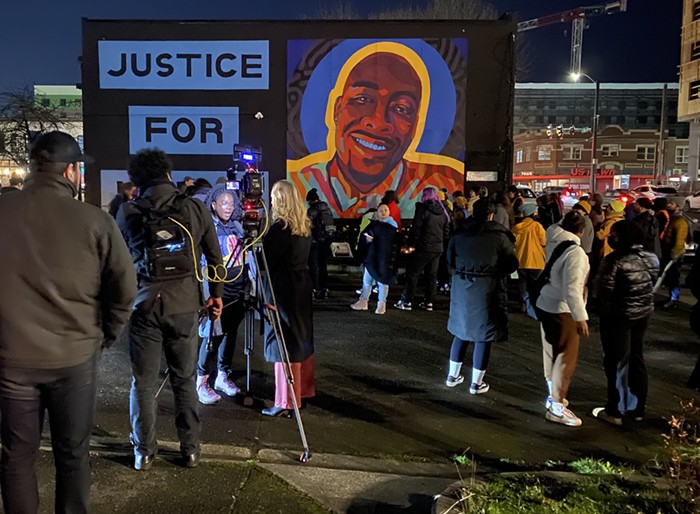The street is a few blocks west of the Maple Leaf neighborhood, I-5, and Northgate Mall. As you walk east from the grimy auto parts "Tec" shop on the corner, there's an abandoned lot, a garage with busted windows set back from the street, a low-slung duplex, a swath of tangled shrubs, and a discarded washing machine on the corner.
Back in 2001, a Seattle developer named Matt Howland wanted to tear down the nondescript duplex and the garage and build a pair of 35-foot-high townhome complexes on the site. To do so, Howland needed the city to rezone one side of the street. The south side of 113th Street is zoned for multi-family but the north side of the street, where the townhome complex was proposed to go, is zoned for single-family housing. A large white sign was hammered into the ground on two wooden stakes, in front of the derelict garage--a "Notice of Proposed Land Use Action" listing specifics about the proposed development, including the project number, the address, and information about the public comment period.
Three years later, the sign in front of the empty garage on North 113th Street is marked with graffiti. For the Maple Leaf Community Council, the dilapidated sign is a trophy in their fight against increased density. Neighborhood leaders like Maple Leaf Community Council member Barbara Maxwell had denounced the proposed development. Maxwell wrote the city two years ago: "Approval of this rezone could lead to a gradual erosion of single-family residencies... which in turn could lead to the destruction of the stable single-family neighborhood."
Neighbors, like Maxwell, see 113th Street as their last line of defense, protecting the community from the urban commercial and multi-family zones that abut the area on its immediate southeastern flank--where the neighborhood gives way to busy intersections like Northgate Way and Meridian Avenue with its dry cleaners, teriyaki place, a florist, Marita Ramos Hair Design, a 7-Eleven, an Arby's, a gas station, and bus lines (the 316 takes you downtown).
"We now enjoy a pleasant view... of Mt. Rainier and the surrounding landscape," another neighbor wrote. "The construction of the proposed duplexes would totally obstruct this view... [and] also threaten our privacy." (Actually, developer Howland's 35-foot proposal exactly matched the zone's own 35-foot limit, but never mind.) Another neighbor added: "I am opposed to my neighborhood becoming one of those parts of the city where one has to hunt for a parking space. It would be a shame if those spaces vanished just to support higher population density."
Complaints like these prevented Howland from building his townhouses. In May 2003, the city's hearing examiner reviewed Howland's proposal and weighed it against the neighbors' objections. Although, the examiner's decision noted that Howland's plan actually fit in the neighborhood and would add much-needed housing options in Northgate, it killed the plan based on a strict city policy technicality against putting multi-family housing in single-family zones.
"I felt a sense of relief," Maxwell, 55, a 30-year Maple Leaf resident says. "I didn't want us to get into the habit of looking to build outside the urban centers. It isn't just about 113th. The larger question is: What is the policy toward single-family zoning?"
While the abandoned plans clearly heartened the Northgate area NIMBYs, it's hard to defend what they managed to save. The north side of 113th Street is not an attractive block: There are no sidewalks; an Escort LX with a missing engine is stranded up on an overgrown grass slope with a few other cars, the driveways along the block are little more than makeshift dirt roads; "For Rent" signs are propped up in windows; and an overgrown grass field, littered with an overturned shopping cart and a plastic 7-Eleven Brain Freeze Slurpee cup, sprawls between the junked cars and the garage.
"It is such a dismal piece of property," lefty City Council Member Peter Steinbrueck, chair of the land use committee, says. "Why protect property in that condition? What purpose are we serving? This graphically illustrates where policy is irrational. Does the neighborhood prefer to perpetuate this, or would they rather see buildings and street improvements that come with development, like sidewalks and trees?"
Unlike most Seattle politicians, Steinbrueck wasn't content just to "ask the tough questions" about 113th Street. The two-term city council member set out to do something about it. Steinbrueck, who lives in Northgate, says he's "gleeful" about the changes he's witnessed in the past 15 years as density has sparked mixed-use development--and a sidewalk where there wasn't one--just two blocks from his Northeast 120th Street home. So he brought North 113th Street to his December 8 land-use committee meeting. He proposed a change to the city's Comprehensive Plan: A pro-density amendment that would ease building restrictions in single-family zones. (A hefty 63 percent of Seattle is zoned exclusively for single families.)
By igniting a debate between old Seattle and new Seattle, or between red Seattle and blue Seattle, Steinbrueck is attempting to break through an issue that's paralyzing our city: How do we accommodate 47,000 new households in the next 20 years? It's a standoff between those who continue to see Seattle in suburban terms and those who understand that Seattle is an actual city, an urban area, and that it must allow for the kind of density that defines urban life.
Steinbrueck's amendment blew up at the council like a land mine, and the December 8 committee meeting ended in a "divided report"--meaning the committee couldn't reach any agreement, and the issue would have to be fought out in full council five days later. Urbanist Steinbrueck and his Not in My Back Yard rival, Council Member Richard Conlin, who opposed Steinbrueck's amendment because "the neighborhoods are very nervous," both left the meeting to lobby their colleagues.
Steinbrueck's amendment isn't just about a bunch of townhomes near Northgate. In seeking to amend the city's Comprehensive Plan to make multi-family housing possible in more places, Steinbrueck is correctly challenging the status quo, taking up a long-overdue fight to make Seattle a real city.
* * *
Ten years ago the state mandated that cities all over Washington, like Seattle, adopt local Comprehensive Plans to accommodate the region's much-anticipated growth with environmentally savvy tactics to prevent sprawl and promote density. (Density, technically speaking, is a measure of households per acre.) Seattle, currently averaging about 5.4 houses per acre, fell far short of its 2004 goals--only hitting 40 percent of its density benchmarks on average. Northgate, where Howland's townhome plan was rejected, hit just 5 percent of its density goal, adding only 171 households instead of a hoped-for 3,000. Northgate's density is currently 8 units per-acre. (A little context: A dense neighborhood like Capitol Hill has 31 units per acre, while a single-family zone like Maxwell's Maple Leaf has 5.5.)
By state law, the city council was required to update Seattle's Comp Plan this year. In August the city presented its list of proposed Comp Plan amendments, Steinbrueck's among them. The list of recommendations, also coming from pro-density Mayor Nickels, hit all the classic smart-growth themes: promoting mixed-use development, linking public transit and development, discouraging car use--all part of a regional strategy to fight sprawl by promoting density in urban centers where the infrastructure is already in place or planned. It's a wise approach. New residential development in undeveloped areas demands more in services than it contributes in taxes--and existing residents typically foot that bill, according to Smart Growth America, a Washington, D.C.-based coalition of smart-growth advocacy groups. Smart growth also delivers savings in infrastructure costs. A recent analysis by Rutgers University determined that modest increases in density could reduce total capital costs by 25 to 60 percent for roads and 15 to 40 percent for water and sewer infrastructure.
Not only does density make sense economically, but dense urban areas are also better for the environment. The population of New York City, for example, is greater than that of 39 states. But because dense apartment housing is more energy efficient, New York City uses less energy than any of those states. And, of course, there's also comprehensive mass transit in NYC, which reduces auto use. Conversely, suburban living--designed for cars and single-family houses flanked by large pesticide-soaked lawns--saps energy, consumes land, and results in the construction of more and more roads.
Seattle's proposed Comp Plan revisions laid out specific policies to meet the smart growth density goals: increasing building heights downtown; directing urban growth to urban centers like Capitol Hill, Northgate, the University District, and South Lake Union; eliminating parking requirements in urban centers--so development doesn't cater to Hummer-driving yuppies; easing restrictions on mixed-use development; and, like Steinbrueck's amendment, easing restrictions on multi-family housing.
Of course "smart growth" urban planning has its flaws. While knee-jerk, Not in My Back Yard reactions to sensible proposals to increase density--like Northgate's reaction to Howland's townhome proposal--is maddening, there are legitimate cautionary notes. Low-income housing advocates like South Seattle's Carolee Colter raise compelling questions about a potential negative effect of development-driven density: a net loss of affordable housing. "The market alone can't be depended on to take care of everybody's housing needs," Colter, who famously fought the Holly Park redevelopment in Rainier Valley, says. "This is going to cause more and more people to be driven out of the city."
When you up-zone an area for more density, Colter explains, you give developers an incentive to build new housing, and those developers want to make their money back. As a result, old housing--including existing multi-family housing--is replaced by more expensive housing. "The people who lived in the housing being replaced aren't going to be able to afford to live in the new developments," she says. Colter points out, quite logically, that building new housing is more expensive than tapping existing housing.
Colter also questions liberals' assumptions about the ability of urban infill to save the environment. "There's a conventional wisdom," she says, "that density is good for the environment, but if housing becomes so expensive in the core of the city, you'll just have poor-people sprawl instead of rich-people sprawl."
None of this, however, justifies neighborhood efforts to save dilapidated blocks like North 113th Street. While Colter's critique has merit, it sidesteps a glaring fact about Seattle's housing market--a fact that shows exactly why pushing for increased density is a necessary and overdue strategy for Seattle: Currently, a startling 63 percent of Seattle is zoned exclusively for single-family homes. Single-family units, obviously, are more expensive than units in multi-family housing. The problem is compounded by the fact that setting aside so much city property for single-family homes keeps Seattle's supply of units artificially low--which also raises prices. It's simple economics: Low supply equals high costs.
* * *
"To have an absolute airtight prohibition on multi-family housing, given the dearth in places like the Northgate urban center, is inconsistent with our goals," Steinbrueck says. "There is a grave need to increase our supply of affordable housing, which is typically multi-family housing. Single-family housing is no longer affordable to median- and below-income earners in Seattle."
Just look at the North 113th Street multi-family proposal: Up-zoning would have created 12 townhomes for sale at between $250,000 and $300,000 each versus three homes on the same half-acre, as mandated by single-family zoning, for probably $600,000 each. Indeed, even as the city rejected the 113th Street proposal back in 2003 due to neighbors' complaints, the hearing examiner was impressed with the plan's potential to create more affordable inner-city housing. "The rezone also could result in the production of additional moderate-income housing," the hearing examiner noted, "a positive impact."
"This city wants more affordable housing," developer Howland, who is also on the board of the Seattle Chapter of the King County Master Builders Association, grouses. "And it seems like we're doing everything to stop it."
He's right. As the city got set to revise the Comp Plan this year--with proposals like Steinbrueck's to ease rezone requirements in single-family zones--the same anti-density community councils who succeeded in blocking increased density in Northgate were back again. "We urge you to remove all amendments that would weaken in any way the protections for single-family zoning and neighborhoods," Jeannie Hale, president of the Community Council Federation, wrote to Steinbrueck. "Single-family housing brings and keeps families with children... and those families provide the range of experience and contribute to the quality of life. Cities like San Francisco or Central New York with few children are like plants that never flower. Single-family neighborhoods supply most of the greenery that paint our spring and fall, and with the lakes and Puget Sound, are the lungs that help Seattle to breathe fresh air."
Another letter from the Northeast District Council said, "There is... a concerted attempt to undermine single-family zoning," and that the new Comp Plan language "allows the Department of Development and Planning to argue that 'townhouses, duplexes, and triplexes, etc.' should be allowed in single-family neighborhoods."
Land-use chair Steinbrueck called the worries "paranoid," and rather than caving, he struck back and made the case for density by putting his "113th Street Amendment" in the city's Comp Plan proposal.
"I have a goal for more housing and more affordable housing, and they work together," Steinbrueck says. "If you lock up the supply, then prices go up. I do believe in the laws of supply and demand. Housing prices have risen steadily in Seattle largely due to constricted supply."
* * *
On Monday, December 12, after the city's Urban Development and Planning Committee had deadlocked over Steinbrueck's North 113th Street amendment a few days earlier, the matter was decided once and for all by the full council.
Specifically, Steinbrueck's proposal, an amendment to the city's overarcing Comp Plan, would make Northgate's regulations less restrictive--allowing the DPD to permit zoning changes in single-family zones on a case-by-case basis. Steinbrueck had good cause to revise the Comp Plan--the Comp Plan was the only thing stopping the Northgate development. When, thanks to the neighbors' complaints, the city hearing examiner rejected the townhome proposal back in May 2003, the examiner simultaneously acknowledged that the development was appropriate. "The environmental review showed very minor negative impacts from the proposal," the hearing examiner wrote. "The analysis... would lead to a recommendation that the site be rezoned.... However, it appears that the area Comprehensive Plan prohibits its rezoning from single family."
The hearing examiner pointed out that the rezone would have been appropriate because Howland's development provided a better transition between the single-family zone to the north and the commercial zone to the south than currently exists. Under Steinbrueck's new rules, the DPD would have been able to approve Howland's North 113th Street development.
"The Northgate Plan was developed in the late '80s," a frustrated Steinbrueck says. "It's quite old. There's been a lot of changes since then."
However, standing by the old plan, Council Member Richard Conlin says, "I just don't feel any need to do something [the neighbors] don't prefer."
But Steinbrueck was undaunted by the neighbors--his neighbors. First, he phoned Maxwell an hour before the vote--she had sent him a "sharply worded" e-mail accusing him of betraying the community. He told her he "didn't have to accept the neighborhood stakeholder group carte blanche," and he wasn't going to "sacrifice purpose for process." Then he convinced a majority of his colleagues of his purpose-- that the issue was bigger than North 113th Street. Revising the city rules that currently barricade single-family zones from appropriate multi-family developments was a critical move, and Steinbrueck wasn't scared to push Seattle forward. The vote for change, the vote for his urban ultimatum, went 6-3 in Steinbrueck's favor.
Howland will still have to reapply for his building permit. But at least now, he--and other developers-- won't be rejected out of hand. As a result there's a chance the city won't be littered with vacant lots and abandoned multi-family housing projects.
"I hope we'll see more mixed-use development and multi-family affordable housing like the Howland site in my neighborhood," Steinbrueck said after the vote. "There are other sites like that up the street from me on 125th that have been denied multi-family and mixed-use development because they sit right on the edge of single-family zones."
Those days are over.


















